
Nissan Evalia production halts in India
- Jun 29, 2015
- Views : 5077

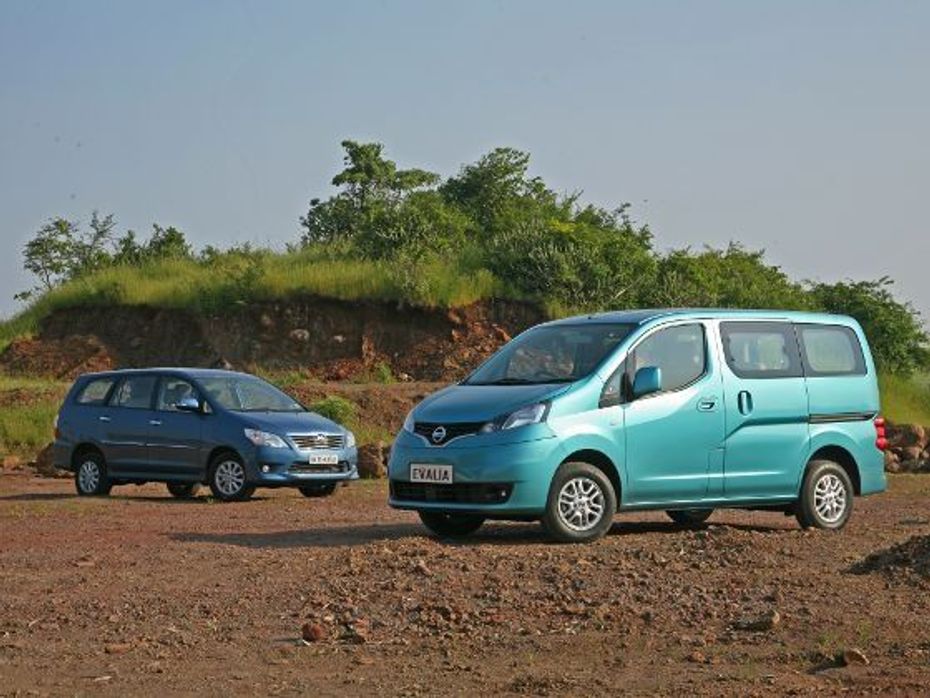
Nissan has certainly kicked its India game up a notch this year. In 2010, the company brought in its first ‘made-in-India’ offering, the Micra hatchback and last year, followed it up with an entry level sedan based on the hatch in the form of the Sunny. This year though, the Japanese auto maker is treating us to a different sort of machine, one that’ll play in a segment that might deal with slightly fewer numbers, but one where the competition is as cut-throat as that in the hatchback market. Yes, we’re talking about the MPV, or multi-purpose vehicle segment, and the car is Nissan’s latest offering, the Evalia. Now as we said, the competition in this segment is quite cut-throat, and we’re not even venturing into the budget MPV segment. Sticking to just the ‘premium’ MPV, the incumbent ruler here is the Toyota Innova and there is no better vehicle to compare the Evalia to.
While these two cars might be designed to serve a similar purpose, they’re as different as chalk and cheese. The Innova sticks with a traditional body-on-ladderframe chassis design, while the Evalia has a monocoque chassis much like a modern sedan or hatchback. The Innova uses an engine that you would expect to see doing duty in an MPV, a 2.5-litre diesel motor, while the Evalia uses the same 1.5-litre DCi diesel engine that does duty in all of Nissan’s, as well as Renault’s, cars in India. There are a fair amount of differences in the equipment levels too and definitely in the pricing as well. But at the end of the day, both these cars are modern, urban MPVs that definitely have appeal that goes beyond your everyday fleet operator.
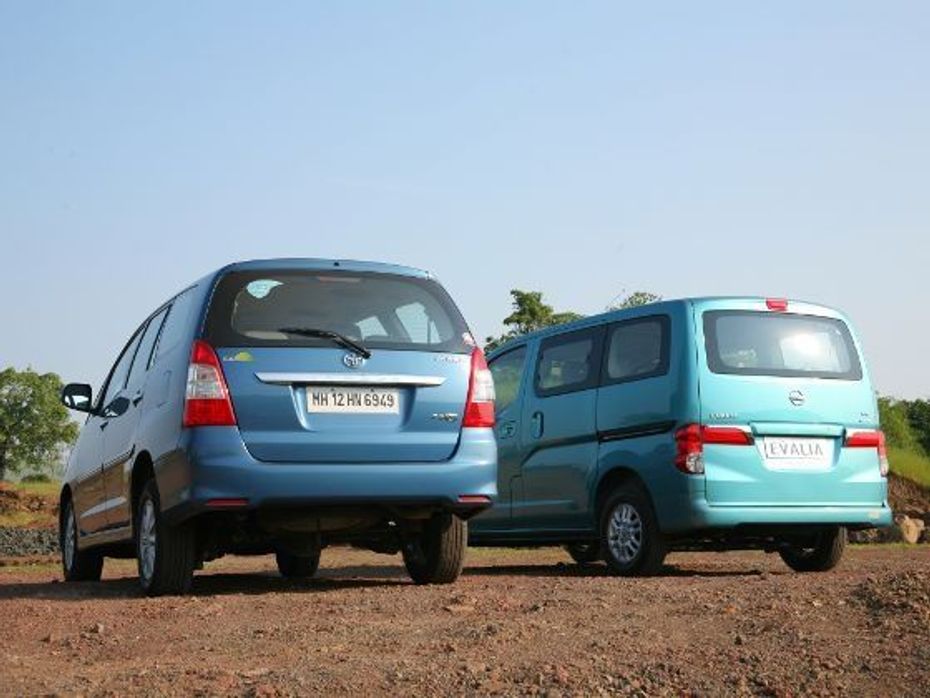
So how do the two of these stack up? Well, there’s no point comparing these cars, or should we say vans, on the standard performance parameters, because let’s face it, they would never really bring out what these two do best. The optimal, and daresay the only, factors to really consider are the space and practicality aspects. Only if a car is actually found lacking in any of the other parameters will there be a strong enough case against it. But we’re dealing with Japanese biggies like Nissan and Toyota here – companies which have refined their ways of making cars right down to a science. So the chance that there will be anything to really complain about in these departments is rather minuscule.
NEXT PAGE: Space and Practicality >>
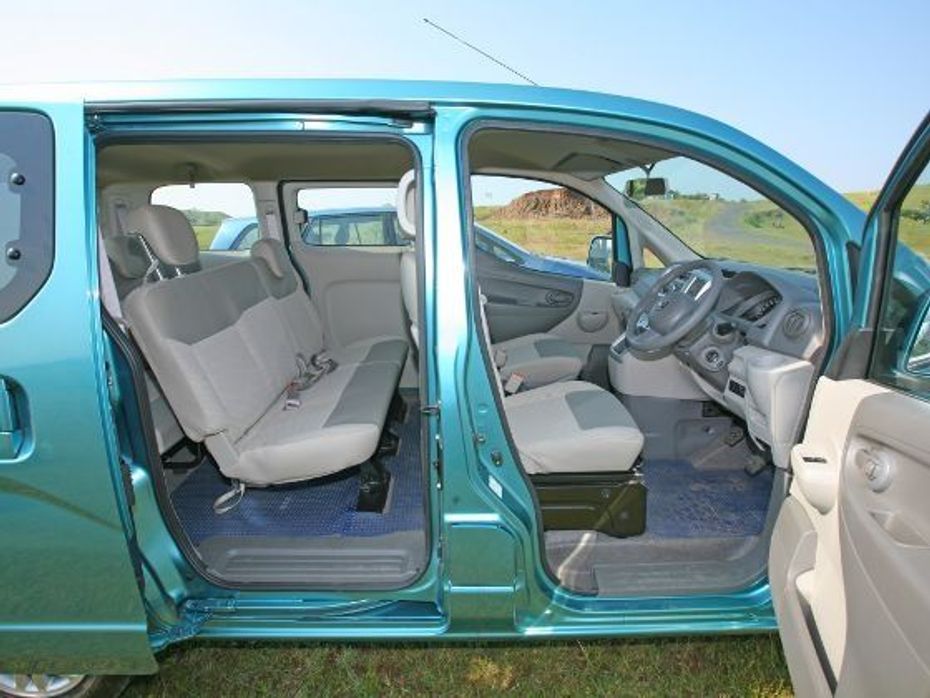
How much and how many?
Space, people and all that jazz
From the outside, both the Innova and Evalia are reasonably large cars and by no means do they give the impression that you’ll be left wanting for space once you get inside. With regards to length and width though, the Innova holds an advantage over the Evalia, with the Toyota being 185mm longer and 60mm wider. But don’t think that for one moment that the same advantage carries over on the inside. The Evalia trumps the Innova in terms of sheer space on the inside, and this boils down to the difference in the chassis design of both cars. As mentioned before, the Innova uses a traditional ladderframe chassis on which the body has been mounted. This design certainly makes the Innova a far sturdier car, but it ends up raising the floor quite a lot. On the other hand, not only is the Evalia taller than the Innova by 100mm, thanks to its monocoque chassis (where the body itself supports the structural load of the whole car), the floor is lower too. To top it off, unlike the Innova, the Evalia is a front-wheel drive, so that means there is no transmission tunnel in the floor for the propshaft to send drive to the rear wheels, making the Nissan’s floor much flatter. This frees up a huge amount of space in the Evalia and the head room that it offers is absolutely unbeatable.
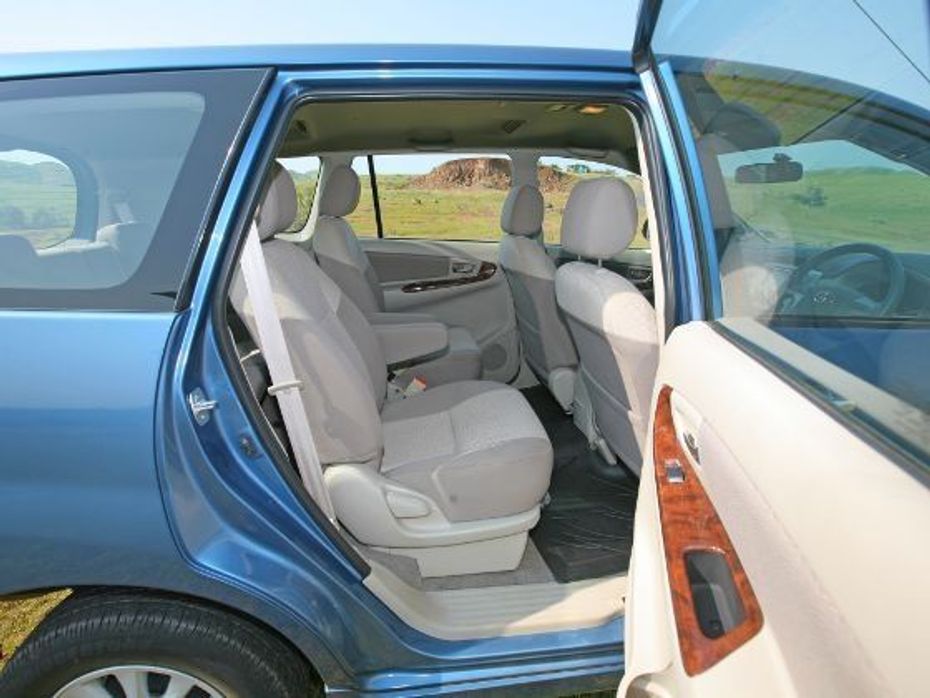
The other advantage that the monocoque offers is a lower loading lip for the boot, which makes it easy to stow heavier stuff as it involves less lifting. And speaking of boot, with the third row jump-seats in place, the Innova barely has room for a couple of backpacks, while the Evalia can swallow up a large suitcase (or two) with the utmost of ease. And then there’s the shape of the boot aperture, which is almost a perfect square in the Evalia, again making it easier for larger objects to be loaded in. Even for the passengers, the Evalia’s sliding doors (though they might not appeal too much on an aesthetic level) make ingress and egress a breeze, even if tightly parked between other vehicles.
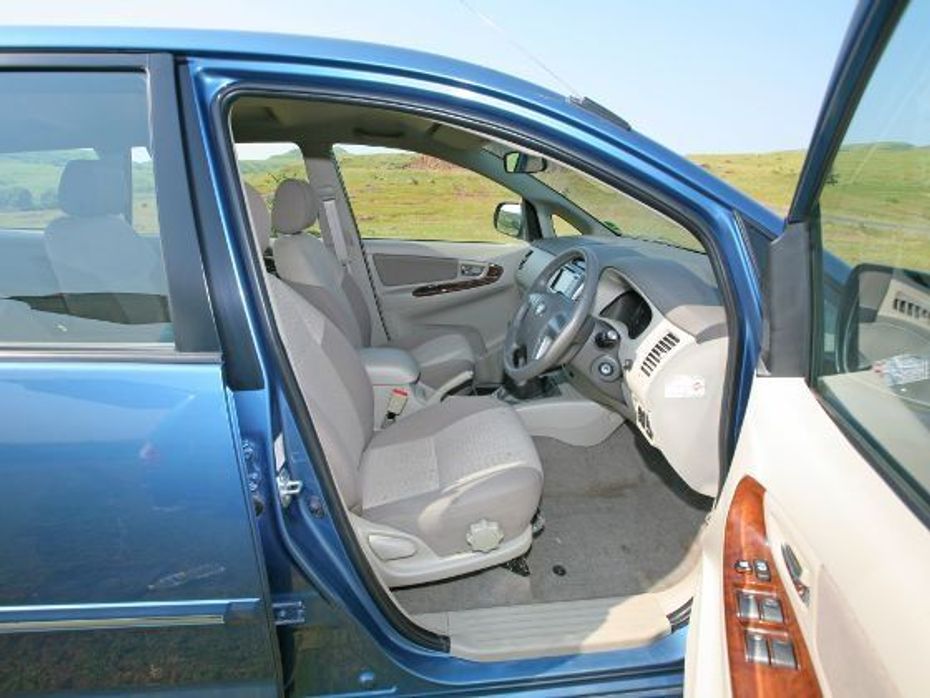
To put it simply, on a practicality level, the Evalia has the Innova beat fair and square, and that comes down to the fact that the Nissan has far more van-like characteristics. But when it actually comes to the business of sitting in the car for long durations, you’ll find yourself favouring the Innova more often. The Innova offers an option of captain’s seats for the middle row, and this is the perfect option for most people. Toyota claims this to be a 7-seater, but we don’t know how it would be possible to get three people in the third row. That being said, this 6-seater’s middle row captain’s seats are some of the most comfortable in the business, but it means, unlike the Evalia’s bench-seat middle row which folds and tumbles forward, that they won’t fold away completely if you want to convert the back into a van-bed. But then again, you can always opt for a middle bench seat in the Innova if you so choose, and that bench is still far more comfortable than the Evalia’s.
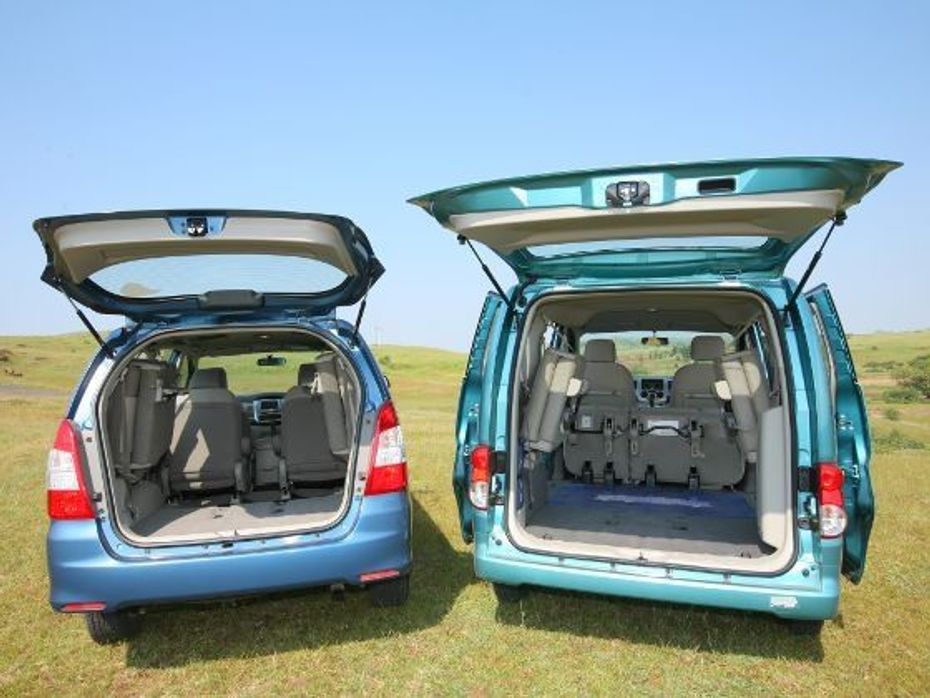
The Innova’s comfortable seating also extends to the front, where the driving position is far more car like as opposed to the more upright van-like driving position in the Evalia. The Nissan has some other quirks as well. While cubby holes and storage spaces are in abundance, the lack of a lid on the Evalia’s glove box does feel like it hinders privacy to a certain extent.
NEXT PAGE: Performance, Ride & Handling, Fuel Efficiency >>
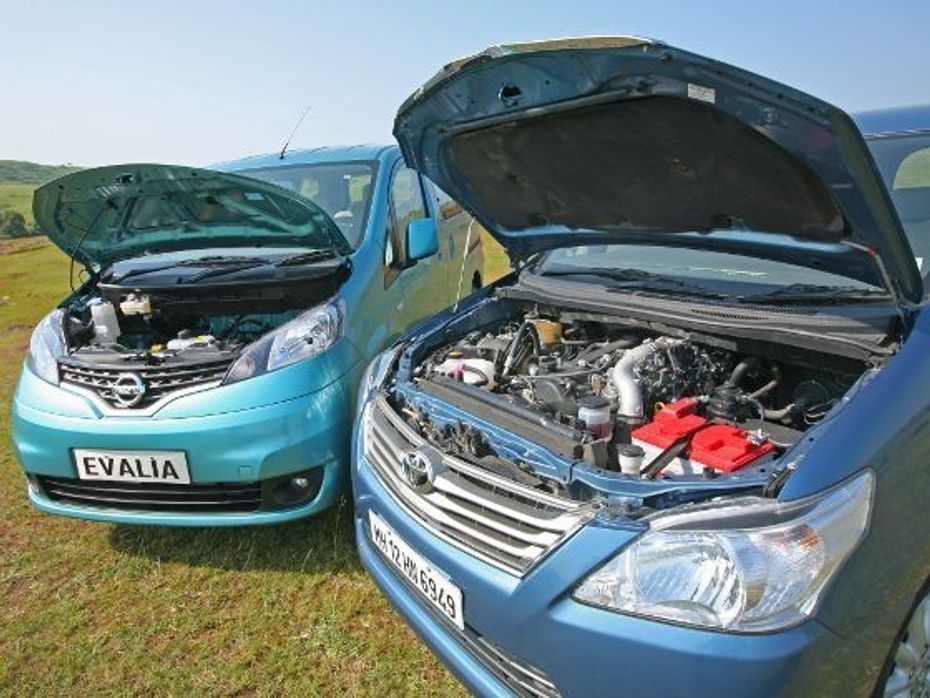
Performance matters
The Innova's 2.5-litre D-4D engine has almost 1,000cc more displacement than the Evalia's 1.5-litre DCi mill. This translates to 102PS of power for the Innova and just 86PS for the Evalia. But surprisingly, both the engines produce the same amount of torque - 200Nm. The Evalia can do the run from zero to 100km/h in about 18.5 seconds while, at 17.1 seconds the Innova does it much quicker. Drivability wise, both cars are quite good, but the Innova's larger engine has more grunt to pull it over any gradient with much more load as well. The only nit we could pick about the way the Innova drives is the amount of force and action required to change gears. The Evalia's gearbox offers a much shorter throw and needs far less effort. But apart from that, the Innova really is the king of the MPVs when it comes to the driving feel.
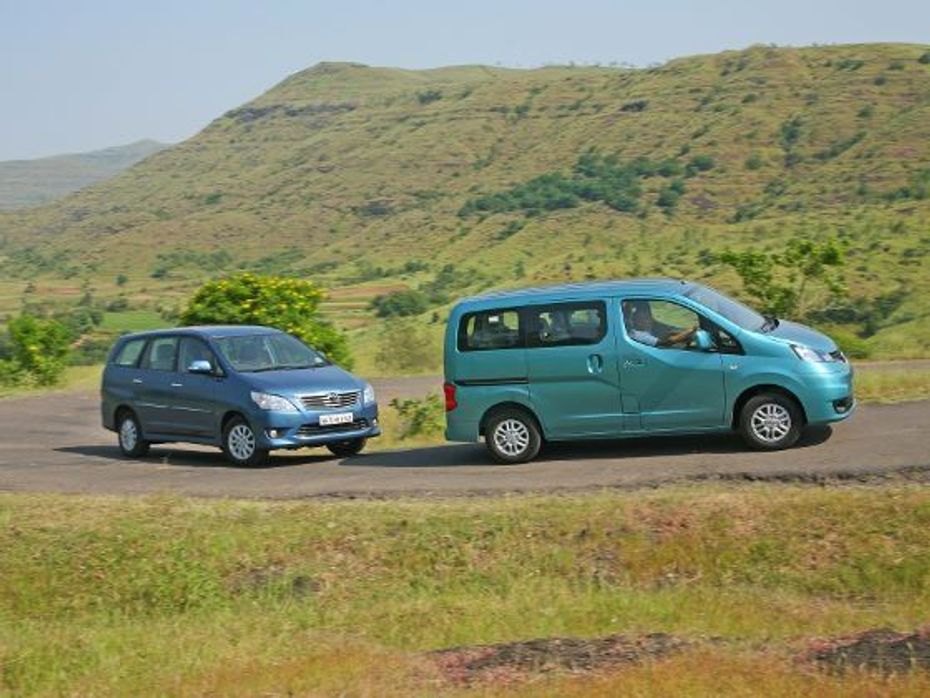
Ride + Handling
The Innova is well known for driving more like a regular sedan than a van. This comes down to the superb driving position, well damped ride and great choice of 205/65 R15 tyres. The Evalia isn't too bad in this department, but the tall body does tend to roll around a bit. Damping is adequate for most situations, but what lets the Evalia down are its LT 165 R14 tyres which are actually designated for transport vehicles rather than road cars. A change over to some good rubber can remedy the Evalia's handling woes, but the Innova is still the clear winner here.
Fuel efficiency
The larger 2.5-litre D-4D engine in the Innova has a 1-litre advantage in cubic capacity over the Evalia's 1.5-litre DCi mill. This means that at speed, the Innova's engine can run much more unstressed and one really doesn't need to rev it much for the car to pull along. This helps the Innova to achieve slightly better mileage figures over the Evalia, though the difference in the long run is not too significant.
Overall efficiency
Nissan Evalia: 12.8kmpl / Toyota Innova: 13.6kmpl
NEXT PAGE: Verdict >>
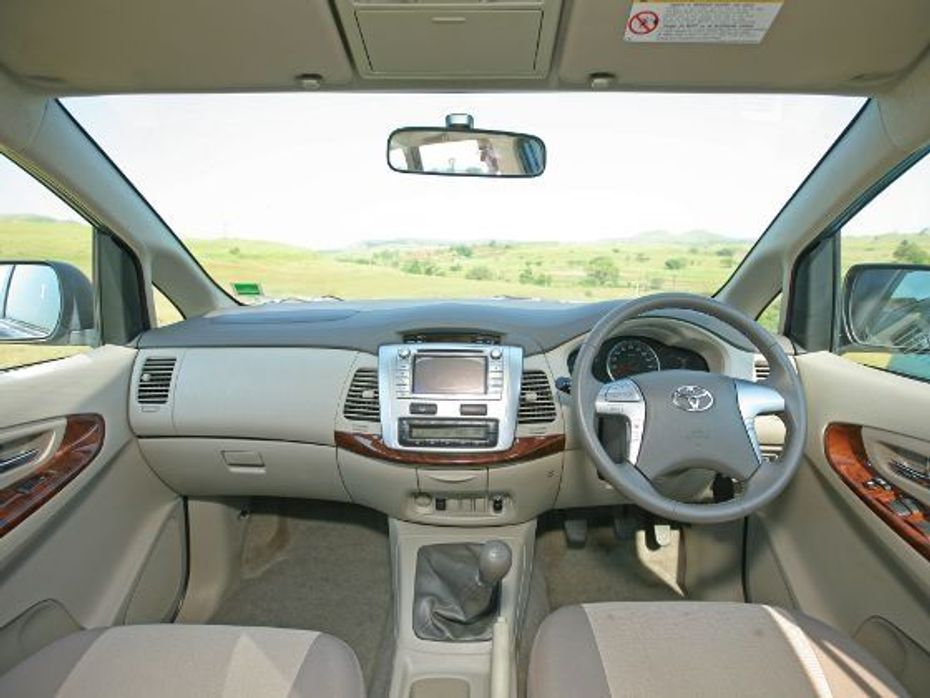
Mr Practical vs Mr Sensible
What it all boils down to
Both the Nissan Evalia and the Toyota Innova are great products. On one hand, with the Innova, you have a proper sedan-like experience in the way it drives, the sheer equipment levels and the overall quality of finish of the product. This makes the Innova an ideal car also for the family buyer. But, and this is a rather big factor, for all these things, you have to pay a pretty penny as well. The top end VX model’s price eclipses the top end Evalias XV’s by nearly Rs 4 lakh. The Evalia on the other hand offers a practicality proposition that is absolutely unbeatable and when you factor in the price, it makes a lot of sense. But it still lacks some of the basic things you would expect from a family car and that makes it difficult to recommend to this sort of a buyer, unless he/she wants a camper van or a van for their rock band. Still, to a fleet operator, the Evalia is the perfect runabout, carrying passengers and their luggage with supreme effortlessness. At the end of the day, if we had to choose one of these two, it’d have to be the Innova, because let’s face it, for buyers like us, sensibility trumps practicality any day.
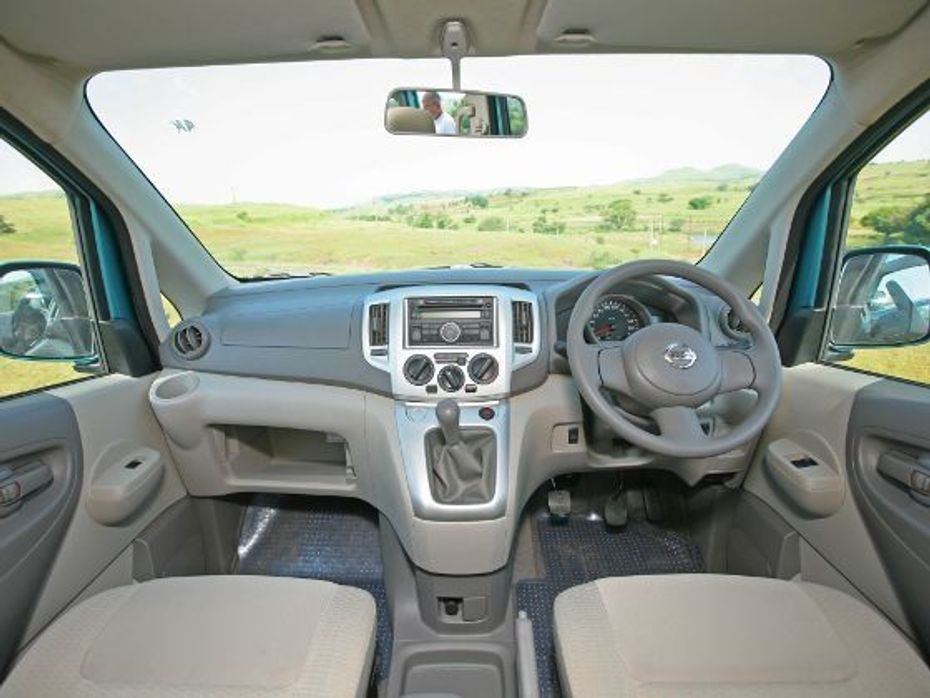

Nissan Evalia production halts in India

Nissan Evalia special variant launched at Rs 11.62 lakh

2014 Nissan Evalia facelift breaks cover

Refreshed Nissan Evalia launched at Rs 8.78 Lakh

Nissan Evalia to transport Red Bull Racing at the 2012 Indian Grand...

Nissan Evalia Launched

Nissan Evalia : Special Coverage

Nissan Evalia all set for launch end of September

Nissan Evalia launching today at expected price of Rs 8 to 10 lakh
India's largest automotive community